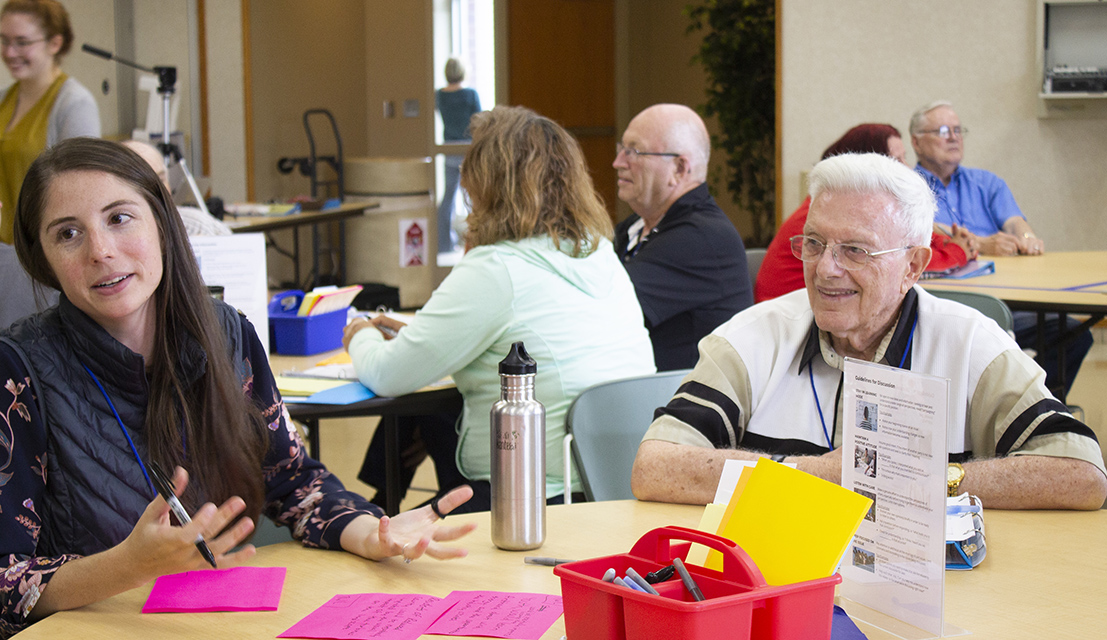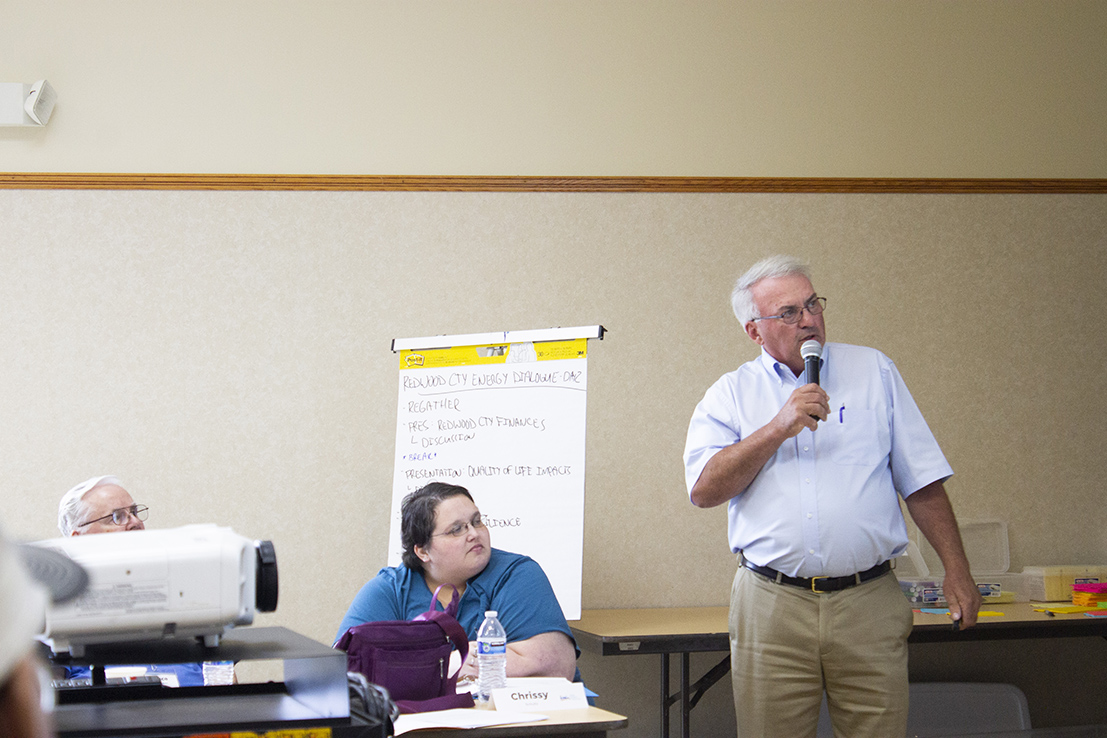Residents of Redwood County love living there–between the strong sense of community, the state’s largest municipal park, and the rich farmland, there’s a solid community identity and sense of place. Recently, something else has started occurring that’s bringing people together: an energy transition.
Places like Redwood County in southwestern Minnesota are on track to house a growing number of wind farms and solar gardens that come with a national shift towards renewable energy. The people who live in and love this community want to inform how this transition happens. Many are wondering, how will we benefit from these projects? And how can we make sure our concerns are addressed?
From September 12-14, 18 residents of Redwood County gathered to grapple with these questions at the Redwood County Energy Dialogue. Over the course of two and a half days, participants heard from local and guest speakers, deliberated over what they learned, and created a set of recommendations to inform potential and future wind energy development in Redwood County. In their final statement, they said, “We can see a future in wind energy and are inspired by the possibility of realizing its benefits. It is important [to get] community input since this will directly or indirectly affect all residents. There are many ways for community members to make a difference.”
Who was in the room?
Some participants were drawn to the discussion because they were already pursuing wind development on their land, while others wanted to learn more about the issue or connect with their community. The group represented Redwood County’s demographic makeup in terms of age, gender, ethnicity, education, political affiliation, and more.

To kick off the Dialogue, participants went around the room and listed what made them proud to live in Redwood County. Repeated over and over was “the sense of community” and “good neighbors and friends.” This sentiment was immediately illustrated by the laughter, smiles, and general willingness of the group to listen and connect with one another, no matter what views or prior knowledge they had entered the room with.
Hearing from the experts
Dialogue participants heard from four speakers (presentations linked): Brian Ross, Senior Program Director at the Great Plains Institute; Vicki Knobloch Kletscher, County Administrator for Redwood County; Shanelle Montana, Senior Project Developer for EDF Renewable Energy; and Gene Metz, a farmer and Nobles County Commissioner.
The first presentation helped get everyone in the room on the same page by exploring why an energy transition is happening in the region in the first place. Markets have shifted so that wind is the cheapest type of unsubsidized energy. As a consequence, states and utilities have made commitments to shift their electric generation to renewables. Xcel Energy has stated it will go 80% carbon free by 2030 and 100 percent carbon free by 2050, and eight states have passed laws committing to 100 percent carbon free electric generation by 2050. This has caused a massive investment in wind energy, which is constructed where the wind resource is the highest. The Buffalo Ridge of southwestern Minnesota has some of the best wind resources in the country, which means the residents of those communities have the most at stake as this energy transition occurs.

The process of building a wind project is long and complicated. It begins with a developer proposing a project, which needs to be approved by multiple entities. First, they must secure leases with landowners willing to host the turbines. Then, the developer must apply for a land use permit from either the state or the county (depending on the project’s scale) and the state or county deliberates whether to approve the land use permit, including soliciting public opinion. The development proposal must also undergo studies of ecological impacts and answer how it will impact the grid, whether there is transmission capacity, and more. As a result of all these steps, the time from when a developer proposes a project to the time it’s up and running can take up to seven years.
The implications of wind development for the county are wide ranging. During the construction of a project, a county could see up to 200 temporary jobs during construction and up to 10 permanent positions to maintain the development once it’s running. This influx of workers can greatly impact the economy of a small town. Also, during the construction process, there’s additional traffic and workers operating heavy machinery, which causes excessive wear and tear on roads as well as on farm infrastructure, including tile drainage systems. Developers pay to repair this damage once the project is running, but it can be a disruption for residents and farmers as the project is being built.

Wind development comes with considerable economic benefits for the county and for landowners hosting turbines. The largest benefit for the county is the wind energy production tax, which in 2018 provided $12.7 million to counties across the state. This additional money does not come out of the pockets of taxpayers and can close some gaps in a county’s operating budget. For farmers who host a turbine on their land, the lease payment can be a gamechanger. Especially in today’s struggling farm economy, the stable income from a wind lease can provide a farmer some economic certainty.
That said, not everyone in a community is the recipient of a lease payment. Although everyone benefits from a higher county budget, many neighbors who do not have a turbine or associated lease payment themselves can come to resent living next to turbines. This is often due to visual impacts–there can be resistance when a familiar and loved landscape changes. Turbines are large–and getting larger as technology advances–and come equipped with blinking red lights that can be visually disruptive, especially at night. These visual impacts are hard to mitigate, so for a wind development to feel worth it to a county, the positive benefits must outweigh the changes to the landscape.
There are avenues for community members to influence the development process. At the county level, there are regular board meetings and public hearings. In Redwood County, there are over 100 committees that residents can join. There’s often a lack of public participation in these processes, but community members are encouraged to make their voice heard. Many participants at the Redwood County Energy Dialogue did not know about these avenues for civic engagement–it’s critical for there to be good and open communication between residents and their local government.

Identifying the biggest challenges and opportunities
After ample discussion, laughter, and debate, the 18 participants co-created a set of benefits and drawbacks for the county to consider when facing potential future wind development. Top benefits included:
- The annual wind energy production tax that would boost the county’s budget
- Financial gains for landowners
- More money spent locally to create an overall better life for residents
Top drawbacks included:
- A lack of opportunity for local utilities to utilize the power generated by the turbines
- The high cost to increase capacity in the transmission grid
- Potential obstacles to farmers, with possible destruction of equipment and repair costs
Participants also brainstormed a long list of recommendations to maximize the benefits and minimize the drawbacks. The full list of participant-identified benefits and drawbacks, along with their recommendations, can be viewed in the final report, available here.
At the end of the event, participants were also asked to answer the question, “Based on what you’ve learned through this experience, do you feel residents should support expanded/future wind development efforts/projects in Redwood County?”
Here’s how they voted:
- Yes, under most circumstances/whenever possible – 56% (10 votes)
- Yes, but only if certain conditions are met/put in place – 44% (8 votes)
- No, not under any circumstances – 0% (0 votes)
What happens now?
The Redwood County Energy Dialogue is the first of a two-community, wind development-focused series of the Rural Dialogues program. The Rural Dialogues offer unique opportunities for community members in Greater Minnesota to share their voice on the future of local energy and to shape energy policy and action. At the end of the event, one attendee shared, “I came into this not knowing one bit of information, so this has been an eye-opening experience. I feel a lot more informed now in terms of communicating information to others.”
When it comes to issues that can be contentious, there are often insufficient forms of engagement to foster respectful conversation and bridge ideological divides. It’s imperative that community members are front and center in conversations about issues that will impact them directly. Wind energy development can only be fair and equitable if the communities hosting it feel and believe in the benefits. The Jefferson Center and the Institute for Agriculture and Trade Policy will continue working with local partners to identify resources and broadly share the community recommendations to turn them into action.
